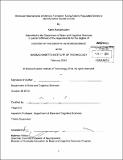Molecular mechanisms of memory formation : using activity regulated genes to identify active neural circuits
Author(s)
Ramamoorthi, Kartik
DownloadFull printable version (17.67Mb)
Other Contributors
Massachusetts Institute of Technology. Department of Brain and Cognitive Sciences.
Advisor
Yingxi Lin.
Terms of use
Metadata
Show full item recordAbstract
A fundamental goal in neuroscience is to understand mechanisms underlying the ability to create memories from sensory experience. While large structures such as the hippocampus are known to be critical for certain types of learning, memories are ultimately thought to be represented in sparsely distributed neuronal ensembles within these larger structures. Currently, there are few tools that allow for the identification and manipulation of these ensembles, which has limited our understanding of the molecular and cellular processes underlying learning and memory. We have previously reported that the activity-regulated transcription factor Npas4 is selectively induced in a sparse population of CA3 following contextual fear conditioning. Global knockout or selective deletion of Npas4 in CA3 both resulted in impaired contextual memory, and restoration of Npas4 in CA3 was sufficient to reverse the deficit in global knockout mice. Taking advantage of the critical role of Npas4 in contextual memory formation, we developed a set of novel molecular tools to gain access to cell populations activated by experience. Using this system, we identified and manipulated the properties of neurons activated by behavioral experience in a variety of neural circuits in mice, rats, and Drosophila. We believe that the tools developed in this thesis can provide a major advancement in the field, and will allow researchers to target any neural circuit activated by experience in a variety of species.
Description
Thesis: Ph. D., Massachusetts Institute of Technology, Department of Brain and Cognitive Sciences, 2014. Cataloged from PDF version of thesis. Includes bibliographical references.
Date issued
2014Department
Massachusetts Institute of Technology. Department of Brain and Cognitive SciencesPublisher
Massachusetts Institute of Technology
Keywords
Brain and Cognitive Sciences.